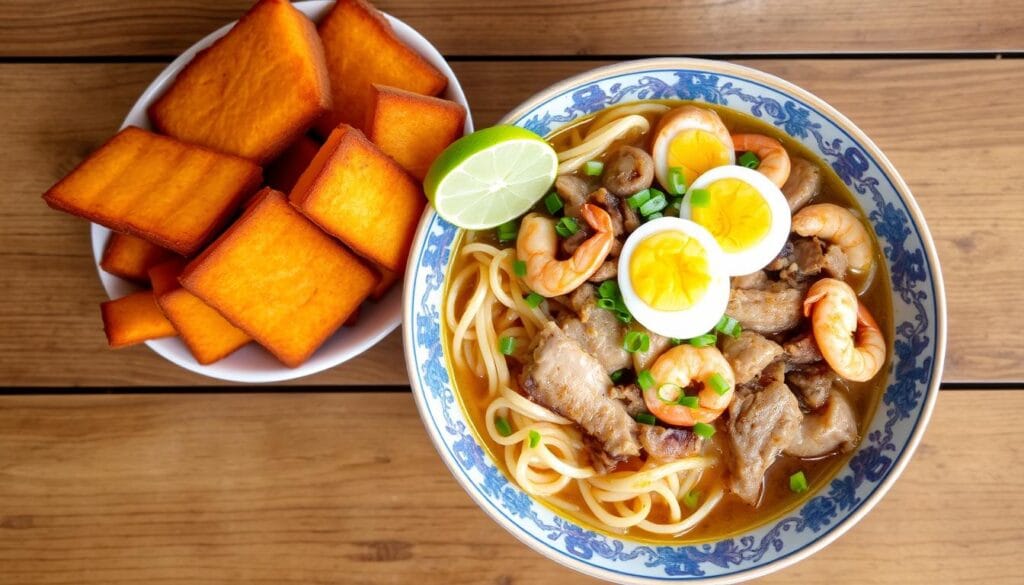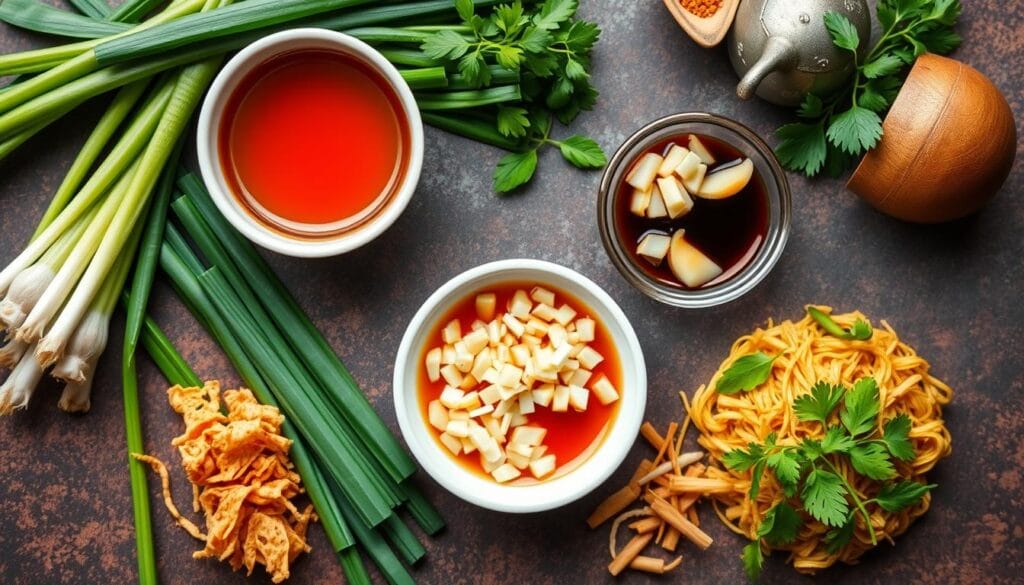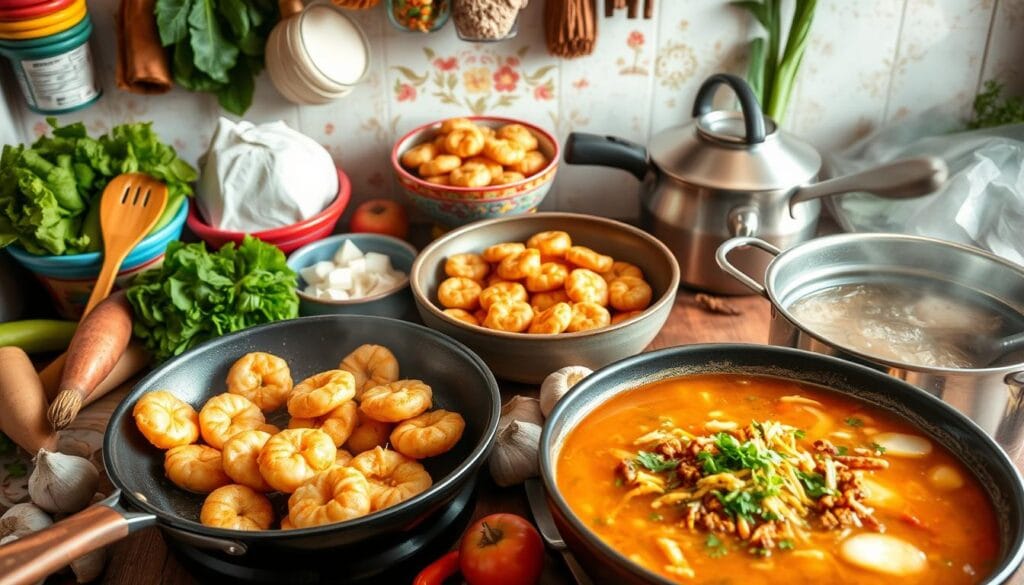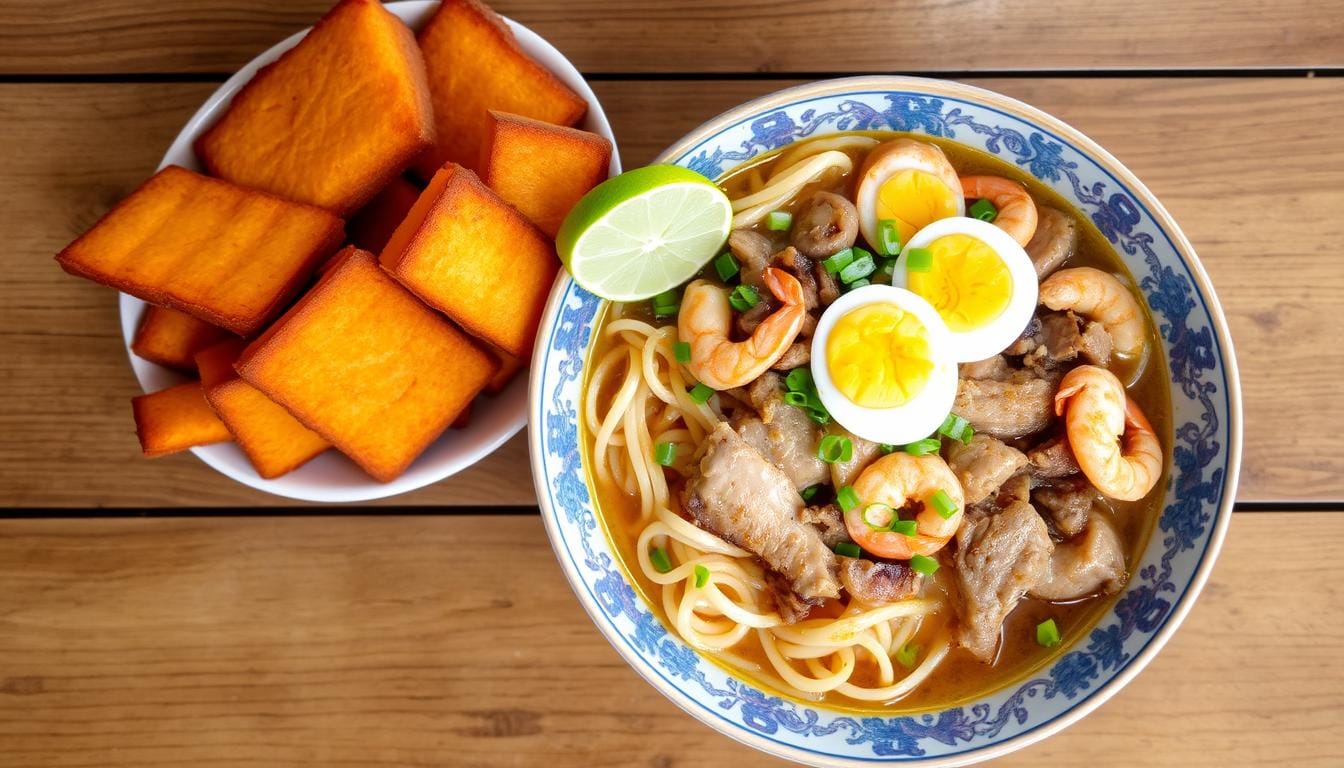I love cooking at home and exploring new flavors. The smell of sweet potato fritters and the taste of shrimp noodles always excite me. They make me want to dive deeper into Filipino cooking.
Today, I’m excited to share a recipe that shows off Filipino fusion cooking. It’s Sweet Potato Ukoy with Palabok. This dish combines crispy sweet potato fritters with the delicious palabok noodles.

If you love Filipino food or just want to try something new, this recipe is for you. It takes you on a journey through Filipino culture. Get ready for a mix of sweet, savory, and tangy flavors in this unique dish.
Table of Contents
A Delightful Introduction to Filipino Fusion Cuisine
Filipino cuisine is a vibrant mix of different cultures. It has changed over time, from Spanish to American influences. At its core, it combines street food with the country’s rich culture.
Origins of Traditional Filipino Street Food
Street food is a big part of Filipino food culture. Ukoy, a tasty fritter with sweet potatoes and seafood, is loved by many. It shows the creativity of local cooks who make simple ingredients into delicious snacks.
Cultural Significance in Modern Cuisine
The mix of ukoy and palabok shows the creativity of Filipino cooking. Chefs and home cooks are making new flavors that honor the country’s food heritage. This blend of old and new shows how Filipino cuisine is always evolving.
“Filipino cuisine is a melting pot of cultures, where the flavors of the past and the present come together in a delicious symphony.”
Exploring Filipino street food, cultural cuisine, and fusion dishes opens up a world of flavors. From the sweet ukoy to the complex palabok, each bite shares a piece of the Philippines’ food story.
Understanding Sweet Potato Ukoy with Palabok Recipe
Sweet Potato Ukoy and Palabok are two favorite Filipino dishes. They show off the country’s vibrant flavors and textures. Ukoy is a crispy fritter made from shredded sweet potatoes. It pairs well with Palabok, a creamy rice noodle dish with a rich shrimp sauce.
The sweet potatoes in Ukoy add sweetness and color. Carrots and bean sprouts make it crunchy. Palabok has a sauce with shrimp broth, annatto oil, and toppings like eggs and crushed pork rinds. This mix of flavors and textures is perfect.
“Sweet Potato Ukoy and Palabok showcase the fusion of flavors that defines Filipino cuisine, blending the crispiness of fritters with the creaminess of noodles.”
Together, these dishes make a complete and tasty meal. They’re great for parties, celebrations, or just a snack. Learning about their ingredients and how to make them will help you enjoy this Filipino dish even more.
Essential Ingredients for Perfect Ukoy
To make the perfect sweet potato ukoy, you need the right ingredients. The sweet potatoes are the main star. The batter and fresh produce add flavor and texture.
Selecting the Best Sweet Potatoes
For the best sweet potato ukoy, pick firm, bright-colored sweet potatoes. Orange-fleshed ones are great because they’re sweet and creamy. Don’t use soft or wrinkled ones, as they won’t fry well.
Fresh Produce and Aromatics
Use crisp, fresh veggies like carrots and bean sprouts for a nice crunch. Garlic and onions add a savory flavor that goes well with the sweet potatoes.
Batter Components
The batter is made of rice flour, cornstarch, and baking powder. This mix makes the fritters light and crispy. The starches help them keep their shape when fried. The exact mix can vary, depending on taste and tradition.
By choosing the best sweet potato varieties, fresh produce and aromatics, and making the right ukoy batter, you’ll make a delicious sweet potato ukoy.
Crafting the Perfect Palabok Sauce
Palabok sauce is the heart of the Filipino palabok noodle dish. It’s what makes this street food so beloved. To make the perfect sauce, you need to balance savory, sweet, and umami flavors.
The sauce starts with a rich shrimp broth. Shrimp sauce is key for its unique taste. Cooking shrimp heads and shells in water extracts lots of flavor, making the sauce aromatic and full.
Annatto oil is a must for the sauce. It gets its bright orange color from annatto seeds, adding a nutty flavor. Adding garlic and other aromatics to the oil makes the sauce more complex.
- Shrimp heads and shells for the broth
- Annatto seeds for the vibrant orange oil
- Fish sauce to provide the savory, umami notes
- Cornstarch to thicken the sauce and help it coat the noodles
The sauce gets its flavor from Filipino condiments like fish sauce, calamansi, and ground pork. These ingredients work together to enhance the dish’s taste.
“The palabok sauce is the heart and soul of this beloved Filipino dish. Crafting it with care and attention to detail is the key to unlocking its true essence.”
Making the palabok sauce requires patience and a gentle touch. Slow simmering blends the flavors, creating a smooth sauce. With the right ingredients and techniques, you can make a sauce that takes you to the Philippines’ vibrant streets.

Kitchen Equipment and Tools Needed
To make traditional Filipino street food, you need some key tools. Whether you like old ways or new gadgets, the right tools are crucial. They help you make the perfect Sweet Potato Ukoy with Palabok dish.
Traditional vs Modern Cooking Methods
In the Philippines, a palayok (clay pot) is used for Palabok sauce. But, a big pot or deep skillet works well in modern kitchens. For Ukoy fritters, a bilao (woven bamboo tray) was used to drain oil. But, a colander or mesh strainer can replace it easily.
Essential Utensils for Success
- A karayom (long metal skewer) shapes Ukoy fritters. But, a fork or tongs can also work.
- A grater is key for shredding sweet potatoes into the right Ukoy batter consistency.
- A fine-mesh strainer makes Palabok sauce smooth by removing lumps.
- A digital or candy thermometer keeps oil at 350°F to 375°F for crispy Ukoy.
With the right tools and equipment, you can get consistent results. You’ll capture the authentic flavors of this delightful Filipino fusion dish.
Step-by-Step Ukoy Preparation
Learning to make crispy frying techniques for sweet potato ukoy is key. Start by mixing rice flour, cornstarch, and baking powder in a bowl. Then, grate sweet potatoes and mix them with carrots and bean sprouts. Coat the mix evenly in the batter for a crispy fritters texture.
Heat oil in a large skillet to 350°F (175°C). Drop spoonfuls of the batter into the hot oil, frying in batches. Fry for 3-4 minutes on each side until golden brown and crispy.
- Prepare the batter by mixing rice flour, cornstarch, and baking powder.
- Grate sweet potatoes and combine with grated carrots, bean sprouts, and other desired vegetables.
- Coat the vegetable mixture evenly in the prepared batter.
- Heat oil in a skillet to 350°F (175°C).
- Carefully drop spoonfuls of the battered mixture into the hot oil, frying in small batches.
- Fry for 3-4 minutes per side until the ukoy is golden brown and crispy.
- Drain the fried ukoy on paper towels to remove excess oil.
“Proper frying technique is crucial for achieving the signature crispiness of Ukoy.”
Don’t overcrowd the pan to keep the oil temperature right. This ensures each ukoy fritter cooks perfectly. Drain the fried ukoy on paper towels to remove excess oil. Serve hot for the best taste.

Mastering the Palabok Assembly
Creating the perfect Filipino palabok dish is about layering and garnishing. Start by cooking the rice noodles as the package says. Then, rinse them in cold water to stop them from sticking. Place the noodles evenly on a plate, ready for the palabok sauce.
Noodle Preparation Techniques
It’s important to handle the rice noodles carefully. Gently separate the strands as you layer them. This ensures they’re evenly spread and avoids clumping.
Layering and Garnishing Tips
- Pour the hot, savory palabok sauce over the noodles. Let it coat each strand.
- Add traditional Filipino garnishes like sliced boiled eggs, crispy chicharrón, green onions, and calamansi wedges.
- The way you layer and garnish is key. It balances flavors and looks great.
By using these methods, you’ll make a rice noodles dish that’s tasty and beautiful. It will show off the vibrant colors and textures of Filipino garnishes.
“The beauty of Filipino cuisine lies in its ability to captivate the senses through the careful layering and presentation of its dishes.”
Professional Cooking Techniques and Tips
Mastering Filipino cuisine requires the right techniques and tips. To get your sweet potato ukoy crispy, heat the oil well before frying. Also, let the shredded sweet potatoes sit in ice water briefly to keep them crisp.
For the palabok sauce, sautéing shrimp heads in annatto oil is key. It brings out the best flavors. Adjust the sauce’s thickness with a cornstarch slurry. Balance the taste with fish sauce and calamansi juice.
- Use hot oil for crispy Filipino cooking methods and let the shredded sweet potatoes sit in ice water to maintain their texture.
- Sauté shrimp heads in annatto oil to enhance flavor enhancement in the palabok sauce.
- Adjust sauce consistency with cornstarch slurry and balance flavors with fish sauce and calamansi juice for optimal texture control.
“These professional techniques can elevate the overall taste and texture of your sweet potato ukoy with palabok, making it a true delight for the senses.”
By mastering these insider tips, you can take your Filipino fusion cuisine to new heights. You’ll show off the perfect mix of Filipino cooking methods, flavor enhancement, and texture control.

Traditional Serving Suggestions and Pairings
When you serve Sweet Potato Ukoy with Palabok, think about adding traditional Filipino side dishes. These dishes make the meal more authentic and show off the variety of Filipino cuisine.
Complementary Side Dishes
- Pickled papaya (atchara) – It adds a tangy and crunchy touch to the ukoy’s sweetness.
- Steamed vegetables – They bring a fresh and healthy contrast to the main dish.
- Garlic fried rice – It’s savory and aromatic, pairing well with the palabok noodles.
Beverage Recommendations
For the Sweet Potato Ukoy with Palabok, try pairing it with these Filipino drinks:
- Calamansi juice – Its bright, citrusy taste is refreshing.
- Coconut water – Its natural sweetness and hydration balance the dish.
The Sweet Potato Ukoy with Palabok is great for special occasions or family meals. Adding these traditional Filipino side dishes and drinks makes the meal more authentic and satisfying.
“Sharing a meal is not just about nourishing the body, but also about nourishing the soul. The combination of Sweet Potato Ukoy with Palabok and these traditional accompaniments is a testament to the rich cultural heritage and culinary diversity of the Philippines.”
Storing and Reheating Guidelines
Proper food storage and reheating are key to enjoying your Filipino fusion dish, Sweet Potato Ukoy with Palabok. Follow these guidelines to keep your leftovers fresh. This way, they’ll taste just as delicious when reheated.
Storing Ukoy and Palabok
For the best results, store Ukoy and Palabok separately. Keep the crispy Ukoy fritters in an airtight container at room temperature for up to 2 days. Refrigerate the Palabok sauce and noodles in separate containers for up to 3 days.
Reheating Ukoy
When reheating Ukoy, preheat your oven to 350°F (175°C). Place the Ukoy fritters on a baking sheet. Reheat them for 5-7 minutes, or until crispy again.
Reheating Palabok
To reheat Palabok, gently warm the sauce on the stovetop. Add a bit of water if needed to adjust the consistency. Carefully toss the noodles with the heated sauce until they’re evenly coated and hot.
By following these food storage and reheating techniques, you can enjoy your Filipino leftover management long after the initial preparation.
“Proper storage and reheating are the keys to enjoying your favorite Filipino dishes, even as leftovers.”
Health Benefits and Nutritional Information
The Sweet Potato Ukoy with Palabok dish is packed with nutrients. Sweet potatoes are full of vitamins A and C, and fiber. They give you complex carbs for energy. The shrimp in Palabok adds lean protein for muscles.
This mix of ingredients makes a balanced meal. It’s good for a healthy diet when eaten in the right amounts.
The dish also has fresh veggies from Ukoy and Palabok. These add more vitamins, minerals, and antioxidants. This makes the dish both healthy and tasty.
If you want to try new foods or need a healthy meal, this recipe is great. It’s both delicious and nutritious. Knowing its health benefits lets you enjoy it often and explore Filipino flavors.

